Summary
Advice: After the secure boot function secure boot will be disabled and Legacy Mode will be enabled on computers with hard drive less than 2 terabytes, the UEFI partition can be completely removed at will (for example, if you no longer need to use Windows 8). This can be done with an application like Gparted).
Compatibility Mode Legacy Mode is an option that usually allows you to install and run operating systems that do not support UEFI. This applies to Windows 7 and earlier, as well as many smaller Linux distributions. By disabling UEFI, the computer will boot directly from the BIOS.
Although Manjaro supports UEFI out of the box, unless compatibility mode has been enabled, the friendly graphical boot screen provided in the installation instructions will not appear. Instead, a clumsy menu will appear. This menu is for UEFI.
Step 1: Access BIOS settings
Advice: No need to follow complex and confusing instructions developed Windows 8 to access your BIOS or UEFI. You can also click on the images below to enlarge them..
UEFI is an add-on system BIOS your computer. Thus, you need to go to the BIOS settings in order to disable the secure boot option in UEFI. To do this, click on one of function keys(F)- usually
Once you get to the UEFI menu, an image similar to this will appear on the screen.
However, as shown, it is still possible to access the BIOS from here, in this case by pressing a key

When going to BIOS settings, a window similar to this will open.
Step 2: Accessing Download Settings
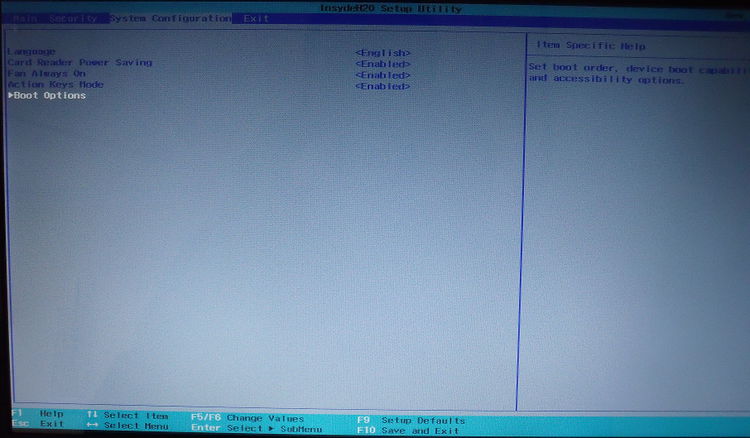
Getting into the BIOS settings, you will be able to use the arrow keys<влево>And<вправо>navigate through tabs (usually Main, Security, System Configuration And exit). Arrow keys can be used<вверх>or<вниз>to highlight and select the settings placed under each tab.
1. Navigate with arrows<влево> / <вправо>to the tab System Configuration.
2. A line will open Boot Options. Select it with arrows<вверх> / <вниз>.
3. With it highlighted, press<ввод>to get to her settings.
Step 3: Activate Legacy Mode
![]()
Attention: We repeat, if the volume of your hard drive more than 2 TB / 2000 GB, you should not enable Compatibility Mode. If Compatibility Mode is already disabled, then your BIOS may try to automatically enable it, enabling Secure Boot along the way.
While in Boot Options, you will see the settings Legacy Support / Mode.
1. Highlight an option Legacy Support / Mode using arrows<вверх> / <вниз>on keyboard.
2. With it highlighted, press<ввод>to enter the menu.
3. As you can see in the photo, a new menu will appear where you can select "Disabled" or "Enabled". Highlight Enabled clicking on the arrows<вверх> / <вниз>, then press<ввод>.
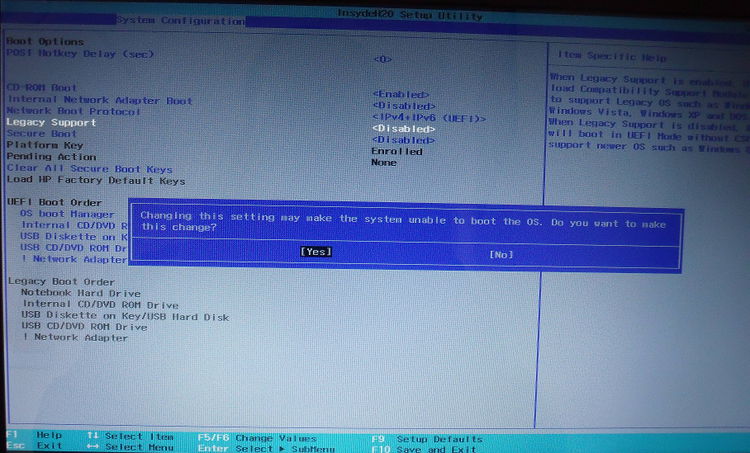
UEFI (Unified Extensible Firmware Interface) technology, like BIOS, is a computer firmware interface, and provides communication between it and operating system. Like BIOS, the UEFI interface (also referred to in Russian-language computer journalism as UEFI) is used to initialize the computer's hardware components and start the operating system stored on the hard drive.

UEFI positioning scheme in the generalized structure of the interaction of PC components.
The BIOS reads information from the first hard disk containing the main boot record(MBR) and selects the boot device where the operating system resides. Since the BIOS is very old system, which has been operating since the mid-1970s, it still operates in 16-bit mode. This circumstance limits the amount of information that can be read from the system ROM (computer read-only memory).
UEFI performs the same task but does it in a slightly different way. It stores all information about the initialization and booting of the system in a special file located on the hard drive in a special ESP (EFI System Partition) partition. In addition, ESP contains boot programs for the operating system installed on the computer.

The process of booting a computer based on UEFI and emulating a traditional Legacy BIOS
UEFI is intended to be a complete replacement for the BIOS in the future and offers many new features and improvements that cannot be implemented in the BIOS:
- No restrictions on the volume of sections and their number. BIOS uses the Master Boot Record (MBR) to store information about the hard disk, while UEFI uses the so-called GPT (GUID partition table). The main difference between them is that MBR uses 32-bit elements, which allows the system to have only 4 physical disk partitions, and each partition can be no more than 2 terabytes in size. As for GPT, it has 64-bit elements, which allows the system to have up to 128 partitions up to a zettabyte (1021 bytes) in size.
- Speed and performance. Since the UEFI technology is platform independent, it can reduce boot time and increase the speed of the computer, especially if large hard drives are installed in the system.
- Safety. The biggest advantage of UEFI over BIOS is security. It is implemented using Secure Boot technology ( safe launch) supported operating system Windows system 8. Since Secure Boot has the ability to request digital signature at boot programs, then the UEFI interface allows only authenticated drivers and services to be used at boot time. Secure Boot controls the boot process until the operating system is fully loaded. This ensures that no malware enters the computer during boot.
- Backward compatibility. For backward compatibility most UEFI implementations on PC architectures also support Legacy BIOS mode for MBR disks. To do this, UEFI has a CSM (Compatibility Support Module, Compatibility Support Module) function. In the case of an MBR disk, booting is performed in the same mode as in BIOS-based systems. It is also possible to boot BIOS-based systems from disks that have GPT.
- Network boot support. UEFI can boot over the network using Preboot eXecution Environment (PXE) technology. This technology supports major network protocols such as IPv4 and IPv6, UDP, DHCP, and TFTP. It also supports downloading from boot images stored in network storages.
- Download manager. The UEFI standard defines the boot manager as a tool designed to boot the operating system and all required drivers. Operating system loaders are stored in files that can be accessed by the firmware. UEFI supports file systems FAT32, as well as FAT16 and FAT12 for removable media. UEFI is independent of boot sectors, although ESP allocates space for them for backwards compatibility. Bootloaders are automatically detected by UEFI software, allowing booting from removable media.
History of technology
EFI BIOS technology was originally developed by Intel. The UEFI standard is currently being developed by the UEFI Forum.
The initial motivation for the development of EFI was BIOS limitations, such as 16-bit processor mode, 1 MB of addressable memory space, which was unacceptable for serious server platforms such as Itanium. An attempt to fix these problems was originally called the Intel Boot Initiative in 1998 and later renamed EFI.
In 2005, Intel put the EFI standard on hold at version 1.10 and handed it over to the Unified EFI Forum, which evolved the standard into a UEFI version. At the same time, the owner of the original EFI BIOS standard continues to be Intel, which issues licenses for products based on EFI technology. UEFI 2.1 was released in January 2007 and adds data encryption, network authentication, and User Interface Architecture technology. The current version of the UEFI 2.4 standard was adopted in July 2013.
Criticism of UEFI
UEFI is sometimes criticized, in particular by advocates of information rights. For example, computer expert Ronald G. Munnich, one of the developers of the alternative open source boot technology Coreboot, denounces EFI as an attempt to limit a user's ability to fully control their computer. In addition, he believes that this technology does not solve any of the long-standing problems of the traditional BIOS, in particular, the need for two drivers - one for the firmware, the other for the operating system.
Conclusion
UEFI is a technology that has both many advantages and disadvantages. To date, it is not yet ubiquitous and is not supported by all computers and other devices. Having a boot manager built into UEFI means that there is no need for separate bootloaders. In addition, this technology can work in conjunction with the BIOS (in compatibility mode - Legacy BIOS) and independently. At the same time, the BIOS can still be used where it is not necessary to store large amounts of data, and the security problem is not extremely relevant.
What is a BIOS?
BIOS (Basi Input / Output System) or basic input / output system - a set of firmware that provides the initial start-up of the computer and initialization of the equipment, recorded in a special microcircuit on motherboard. Provides an API for the operating system to access all available hardware and connected devices. The main BIOS manufacturers are: AMI (American Megatrends), Award Software and Phoenix Technologies.
At startup computer BIOS checks the critical components of the system - POST, i.e. Power-on self-test. If a malfunction or any problem is detected, the BIOS will display information in the form of a message or, more often, will give sound signal. If everything is in order, you will most likely hear 1 short beep and the download will continue.
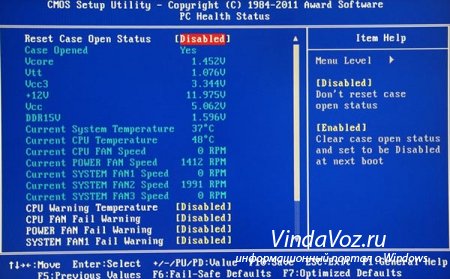
Introduction to UEFI
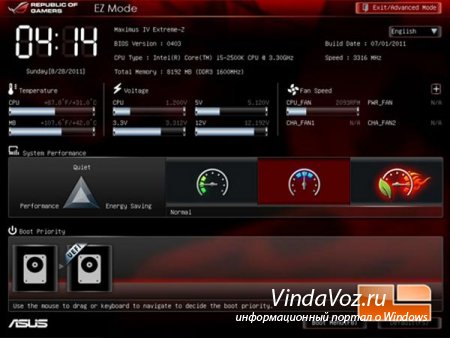
Unified Extensible Firmware Interface - a standardized extensible firmware interface software. The underlay interface between computer components and the operating system. Essentially the same BIOS, only slightly improved. Does everything the same as the standard BIOS, ie. performs a check, initializes the hardware, searches for the bootloader, and transfers control to the OS. It is also endowed with a number of innovations, more on that below.
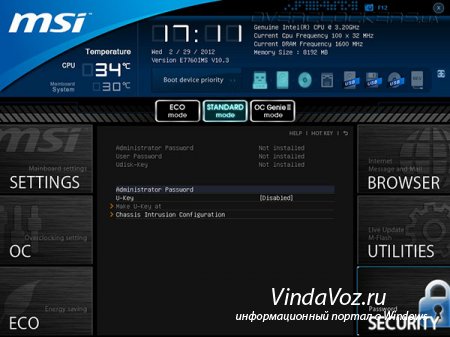
The main advantages of UEFI over BIOS:
1) It takes much less time to boot, which is achieved using parallel initialization, unlike the BIOS, which initializes all components sequentially. You can see the loading scheme in the diagram below. It is also noteworthy that the operating system will be able to use uefi, and not load its own. For example, if you are undemanding to the graphics subsystem, then you can not download, and therefore do not install new drivers, but use the drivers offered by UEFI.
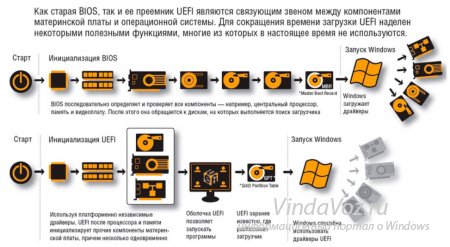
2) Another important advantage is that you can boot from disks larger than 2 TB. The fact is that the BIOS used MBR (Main boot record) is the master boot record, which can only address 2 TB of space, while UEFI uses GPT (Guid Partition Table) - this is another standard for the format for placing partitions on a physical hard drive, which allows you to address as many as 9 ZB (Zettabytes).
3) UEFI also got GUI with mouse support, for whom it is a plus, and for whom it is a minus. Some built-in programs appeared, for example, a browser. Thus, uefi began to represent not only an interface between the operating system and hardware components, but also a kind of .
4) Support for cryptography and other protection methods. There are many nuances in this regard, we will not go into details.
There is nothing radically new, some improvements and improvements, but gradually uefi will completely replace bios.
